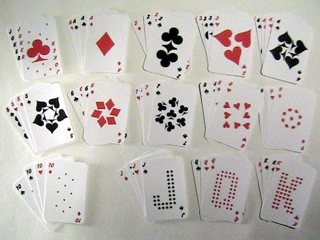My Custom Cards
A "Standard" Deck of Cards

(June 2004)

(June 2004)
I bought a bunch of PlainCards a while back, but I'd only experimented with them, printing digital photos on a stack of them. I have the idea to do a photo tarot deck, but I wanted something I could finish quickly and use to show off the printable cards.
I quickly put together some designs, and printed them out! The suit symbols on the cards not only get more numerous as the value of the cards increases, but the symbols get smaller so they can fit. I'm a horrible illustrator, so I used the cheap symbol-dot-matrix letters for the royalty. If I hadn't done that, this project would probably have been stalled for a week or two while I figured out what to do.
One thing you'll notice about the number cards is that they make heavy use of rotation. Most cards just flip things vertically, if they flip them at all. What's up with that? I wanted my cards to be more swirly, and that's what I have.
Here's what you need:

A few words about the PlainCards: These are one of the greatest products since sliced bread. That said, they're not perfect. The back is a little boring, and only comes in blue and red. (Or blank, which is actually a new offering since I ordered.) The edges have many little perforations, and three big perforations per side. While these perfs have to be sturdy to keep the cards in the sheet through the printer, they do make the cards feel and look homemade. Still better than the uneven cards you get by hand cutting, but fuzzy is fuzzy. The card stock is a great thickness, so the cards come out nice and sturdy. The uncoated face takes ink very well, with little sideways bleed. I haven't noticed any bleed-through, even on the darkest cards. These are a good product; pretty much exactly what I expected. They're a pretty good value, especially considering nobody else sells something like this.
The fine friendly people at PlainCards tell me that they have a new method of making the perforations that results in much smaller perforations and much less fuzziness. I also see from their web site that they have larger cards for flash and tarot cards, and square corner cards for making trading cards like baseball cards. I just may have to get some of those larger cards, so I may find out soon.
Open the PDF in your Acrobat viewer, load up your printer with the plaincards sheets, and print them out. Punch out the cards and start shuffling!